









Raising backyard egg-laying chickens is a great step toward the homesteading lifestyle and more self-sufficiency. In this backyard chicken guide, we discuss everything you need to know about raising egg-laying chickens.

We are fortunate to raise a year’s worth of meat and love raising meat chickens in the spring. They are some of the best homestead animals. But keeping a flock of backyard egg-laying chickens is a priority in our home because of the number of people we have to feed.
Our hens provide us with the best eggs, with deep orangy-yellow yolks and a flavor that far surpasses the grocery store. We make homemade eggnog, perfect hard boiled eggs, pickled eggs, and homemade egg noodles to prevent any single egg from going to waste.
During the spring and summer months, we preserve our extra eggs in a number of different ways to be sure we have enough to feed our family throughout the winter months (our favorite methods are water-glassing eggs, freezing eggs and freeze-drying eggs).
Watch the video or listen to the podcast below to learn everything you need to know about keeping backyard chickens.
Listen and Subscribe: Apple Podcasts | Spotify | iHeart | Google Podcasts
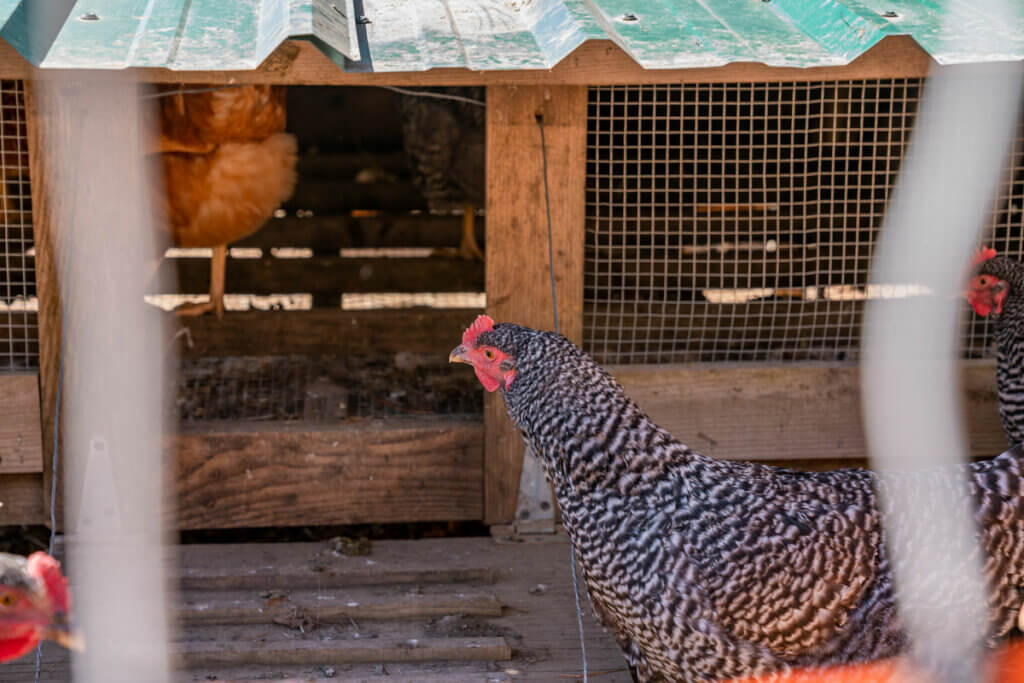
Types of Backyard Chickens
Before you buy backyard chickens, you need to know what you’re going to use them for. There are four different categories of chickens:
- Heritage Breeds – Can be both meat or egg-laying.
- Egg-Laying Breeds – Raised solely for laying eggs.
- Dual-Purpose Breeds – Generally raised for one to two years as egg-laying hens, then butchered for meat.
- Meat chickens – Raised solely for meat as they’re butchered before they reach their egg-laying stage.
We recommend asking people around you who are raising chickens to see what breeds do well in your area. But you can always get a few different varieties and see which you prefer best.
Heritage Breeds
The Livestock Conservancy defines a Heritage chicken as a natural breeding chicken that has a slow growth rate and can live a long, productive outdoor life. As mentioned above, the breed must also conform to the American Poultry Association’s standard for that breed.
Heritage breeds can be both egg-laying chickens or meat chickens. These can even fit into the other categories below.
Each heritage breed has pros and cons for raising them as backyard chickens, so be sure to do your research on each specific breed (and check egg count!) to make sure they’re right for you.
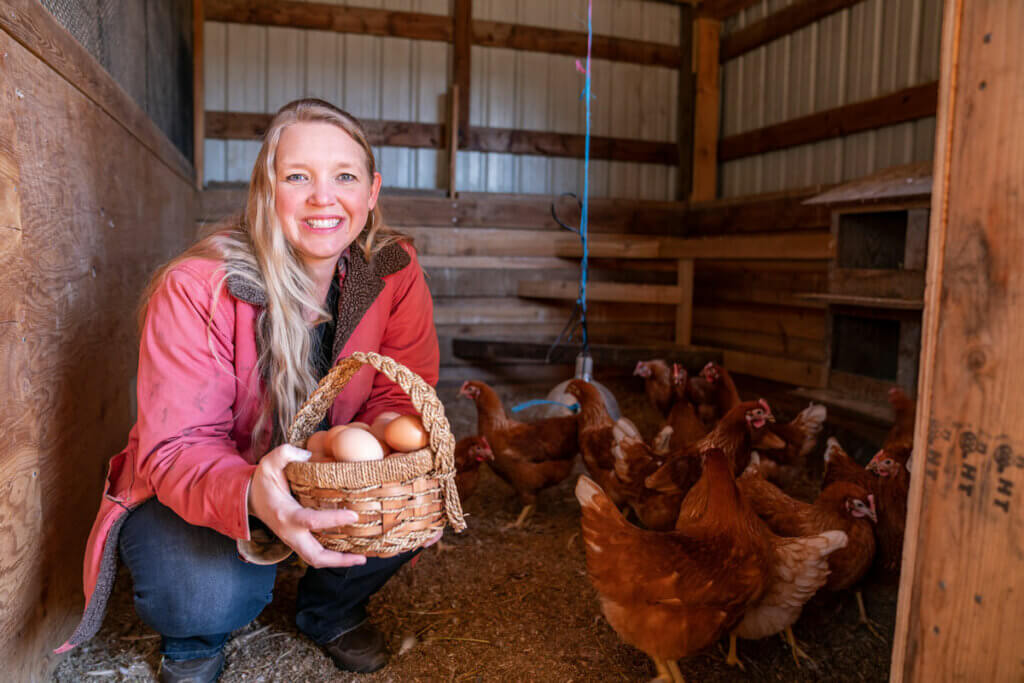
Egg-Laying Breeds
Egg-laying breeds are going to be pretty small birds. They won’t grow to a very large size or provide much meat if you end up butchering them.
Egg-laying breeds will lay an average of about 300 eggs per year in optimal conditions, which is why we really recommend birds in this class if you are primarily looking for eggs from your chickens.
These breeds include Australorp, Leghorn and Novogen Brown chickens (which we love).
Dual-Purpose Breeds
Dual-purpose chickens will lay eggs and grow to a decent size for butchering. Most often, people will buy dual-purpose birds as egg layers for 1-2 years, then after their egg-laying cycle is over, butcher them for meat.
We’ve raised dual-purpose birds in the past and personally don’t recommend them. Although they make a fantastic backyard flock, they won’t lay as many eggs as egg-laying breeds, and they won’t grow as large as breeds meant for butchering.
It’s our recommendation that if you want meat chickens, get meat chickens. If you want egg-layers, get egg-laying chickens.
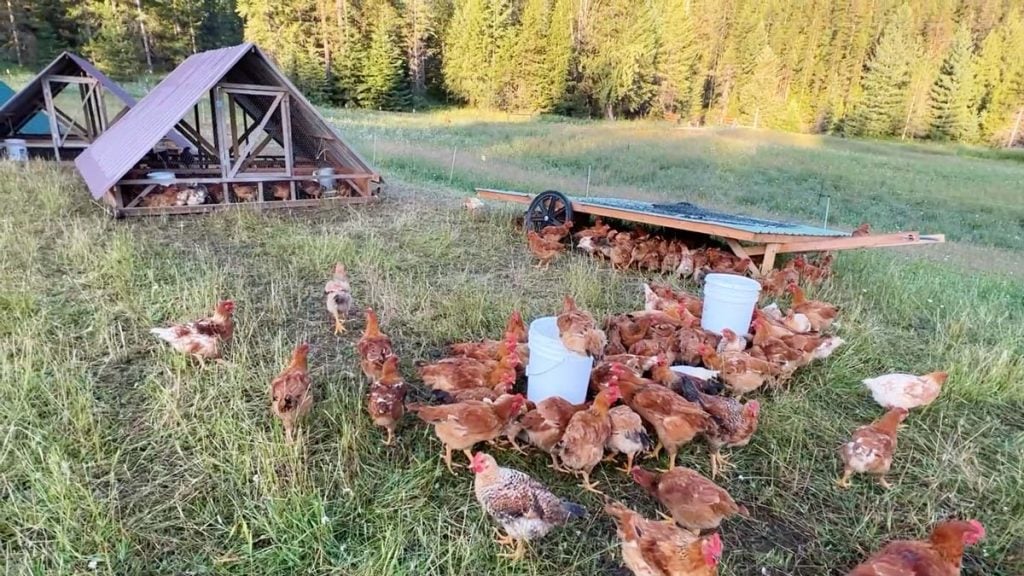
Meat Chickens
Meat chickens are raised in a relatively short amount of time and are strictly for the purpose of filling your freezers. They won’t be around long enough to get to the age where they’ll start laying.
For more info on this variety, check out our post about raising meat chickens.
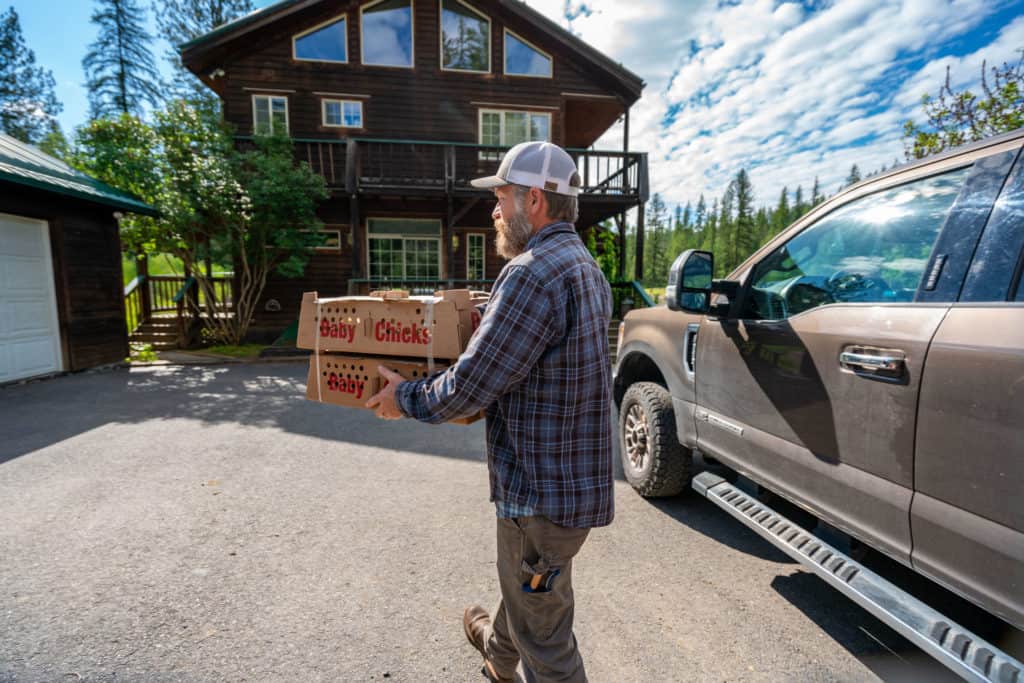
Buying Backyard Chickens
There are a few different options when it comes to getting egg-laying chickens. Some take much more hands-on time and care than others, and there are pros and cons to each.
- Hatch out your own eggs – can be tricky for beginners.
- Buy day-old chicks – our personal recommendation for beginners)
- Buy pullets (our secondary recommendation) – a more expensive option, but gets you to the laying stage sooner and eliminates the need for a brooder.
- Buy year-old chickens – generally gets you hens that are laying now (or soon after their first molt).
Hatching Chicks
Hatching out your own eggs means you need to be set up with an incubator and the understanding of turning eggs and the care needed before they hatch out.
This isn’t something we recommend for first-time chicken owners. Though we think learning and experimenting with this is great for creating resiliency on your homestead, it’s something we recommend trying once the newness of owning chickens has passed, or if you’re starting a homestead business.
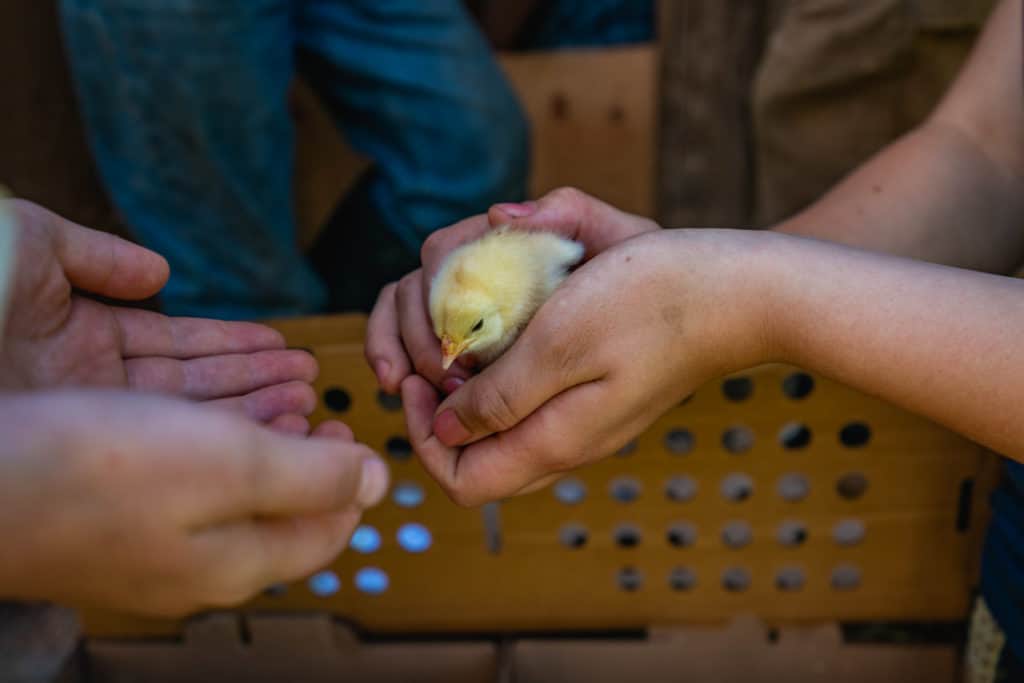
Buying Day-Old Chicks
Buying day-old chicks is probably the most common way to buy egg-laying chickens. It’s our recommendation for those just beginning with egg-laying chickens. The downside is that you’re still relying on an outside source, which decreases your resiliency. However, it’s a great place to get started.
Buying day-old chicks is also the most cost-effective way to get started. You’ll want to be sure you’re ready before you bring them home. Here’s everything you need to know about bringing home baby chicks.
Always try to find your chicks locally, and if you can find a mother-raised chick, this is best. A chick that’s had the experience of being hatched out and raised by a mother is going to be a better mother to their own chicks (this is especially important if you want your hens to hatch out your next batch of egg layers).
Buying Pullets
Pullets are chickens that are 4-6 months old and at “point of lay,” which means they’re about to start laying. The benefit to this is that you miss the entire chick period, where you have to baby the chicks and play mama hen.
These chickens are ready to go into the coop and are just about to start laying.
The downfall to pullets is that they’re more expensive upfront. However, if you break down the costs of raising your own chicks between feed and time, you may find buying pullets is the right direction for you.
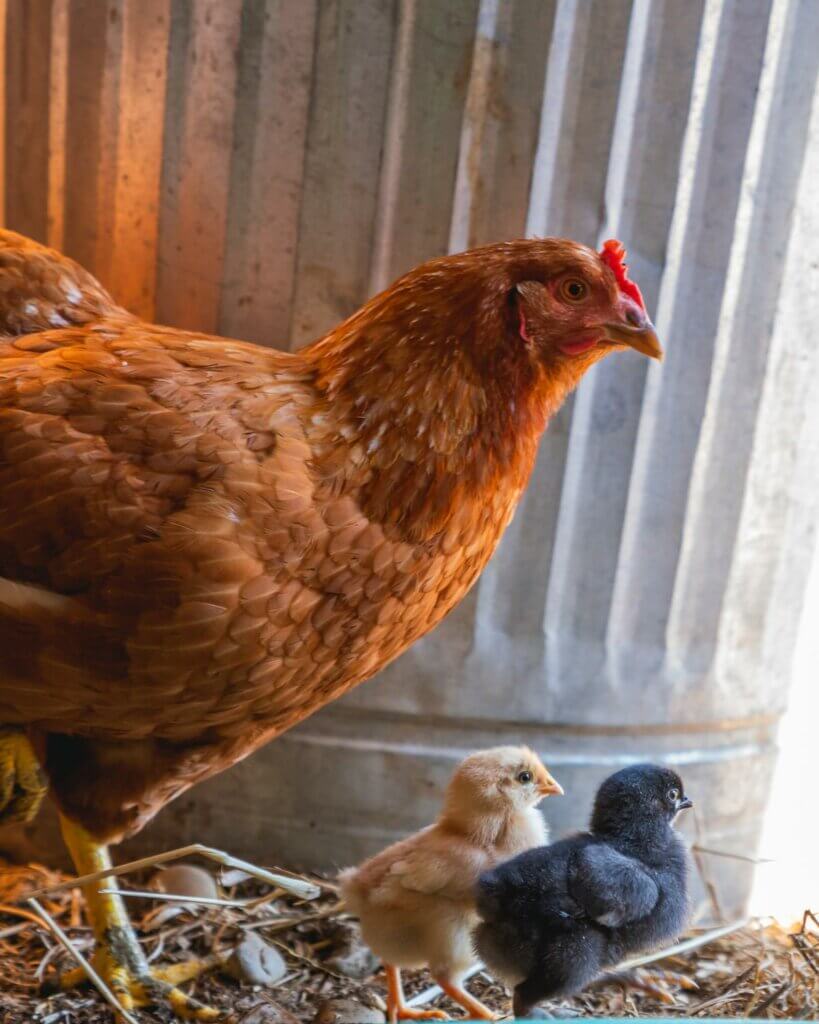
Buying Year-Old Hens
Finally, you can bring in year-old hens. Typically, they’ve already been laying and are at their first molt. This means they’ve stopped laying for a bit, might be losing some of their feathers, etc.
Buying year-old hens means you’ll still get about 1-2 more laying years out of those chickens.
This doesn’t have to be an expensive option if you shop around. Sometimes, there are people selling off some of their flock because they’ve accumulated too many. Or perhaps they started raising backyard chickens and realized it was not for them.
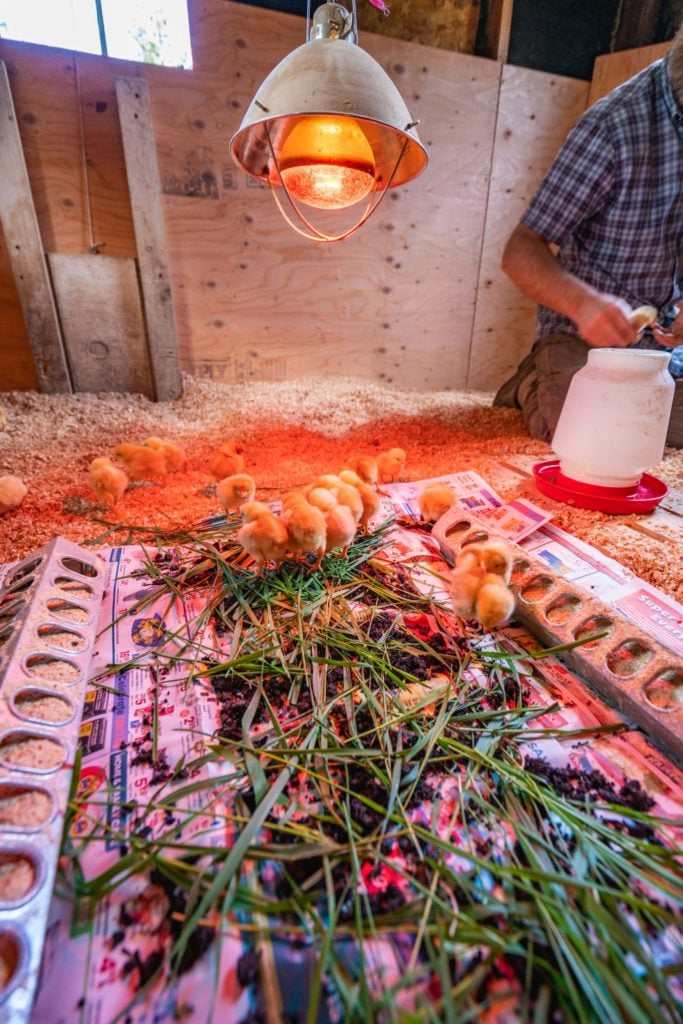
Where to Buy Chicks
If you’re in the market for baby chicks, try to find a local hatchery. Not all cities will have hatcheries, but oftentimes, a feed and grain store or a farm and garden store will take pre-orders and have chicks delivered to the store for you to pick up.
If you can’t find chicks locally, we recommend looking at Freedom Ranger Hatchery. This is where we’ve purchased chicks in the past.
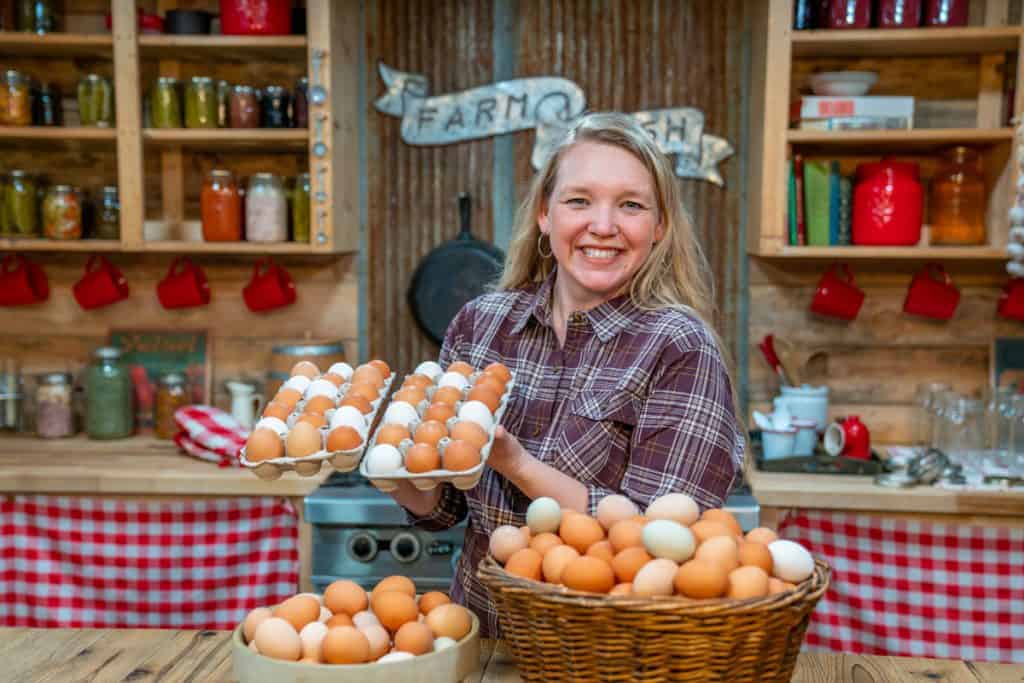
How Often Do Chickens Lay Eggs?
Egg-laying breeds will lay about 4-5 eggs per week. There are certain times of the year when you won’t be getting that many eggs and other times of the year when you will probably be getting more.
If it gets too hot, too cold, or too little light, then their egg production will slow down. You can read this post on why chickens stop laying eggs. It’s good information if you think your chickens should be laying, but aren’t.
We like to allow our chickens to slow down with the seasons, so we don’t use artificial light to keep them laying during the winter months.
Instead, when egg production is at an all-time high, we preserve our eggs by water-glassing them or freeze-drying them. If water-glassed, they will last upwards of 18 months. If freeze-dried and stored correctly, they will last on the shelf for upwards of 20 years.
We generally only preserve enough eggs to get us through the winter until our flock starts laying again.
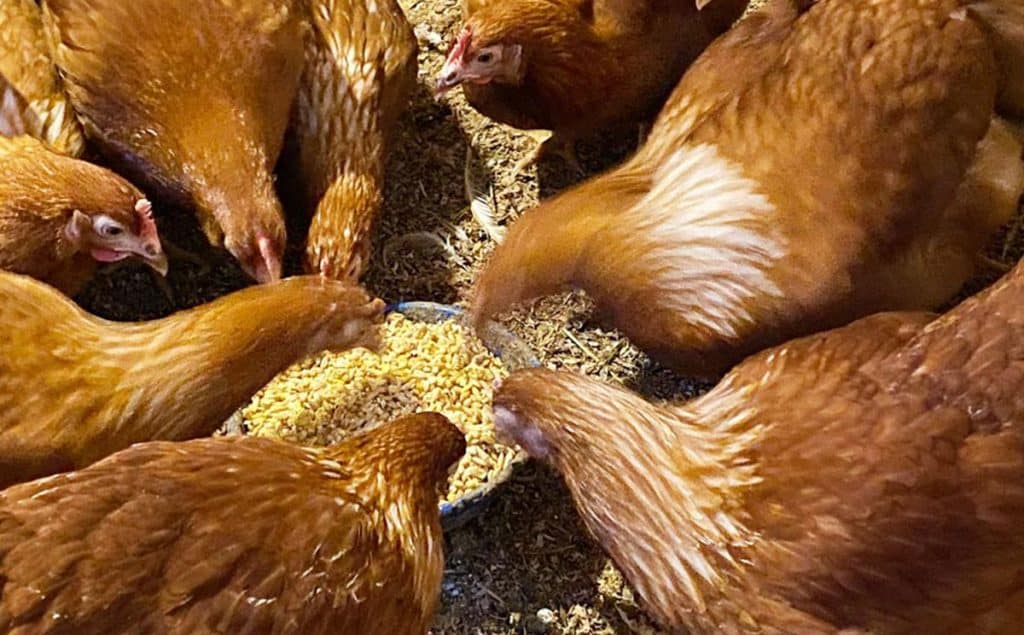
Chicken Feed – What to Feed Chickens by Age
There are many ways to feed your chickens, but there are some basic requirements that chickens need. Feeding chickens is not just about volume or quantity but also what makes up their feed. Their nutritional needs change as they age so you want to be prepared for this before bringing them home.
Feeding Baby Chicks (Up to 7 Weeks Old)
When your chicks are young, you need to feed them very high protein feed (usually 18-20% protein). If you’re buying it, it’s often called chick starter or chick crumbles.
A tip we found that helps with baby chicks is to add some grass, soil and sand to their feed. This helps get good grit into their gizzard and teaches them how to peck and scratch to search for food. This also gets them accustomed to actually eating the “green things.”
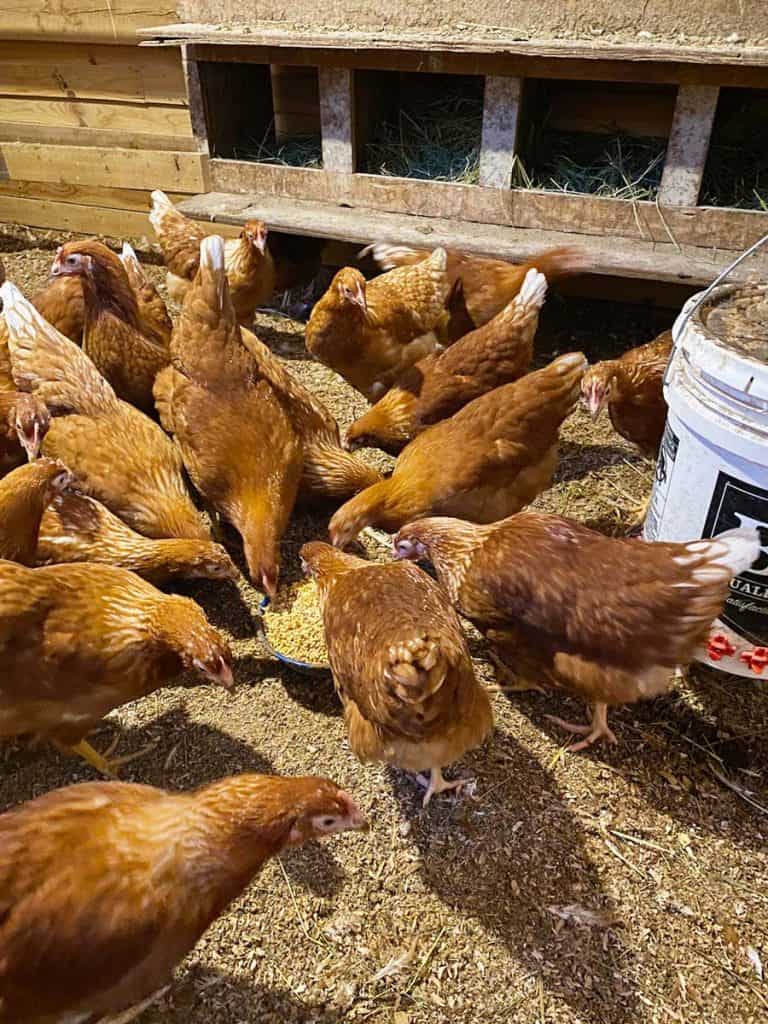
Feeding Chicks 8-14 Weeks
At about eight weeks, chicks need a drop in protein. From 8-14 weeks old, they need a feed with only 16-18% protein.
This drop in protein is so the chicks don’t grow and develop their egg-laying parts too quickly. Rapid growth in chicks can create permanent problems when it comes time for them to start laying.
Feeding Chickens 15-18 Weeks
At this age, chickens can be dropped down to a feed with about 15-16% protein. This is the ideal protein for chickens for the remainder of their life. If chicks are free-ranged with an adequate supply of bugs, you may find they don’t need as much feed each day because they’ll be supplementing with bugs.
If you’re looking for ways to save money on chicken feed, listen to this podcast on feeding your chickens without buying chicken feed. Alternatively, you can give them kitchen scraps and even consider fermenting your own chicken feed for further cost savings.
We’ve practiced all these methods for many years with great success.
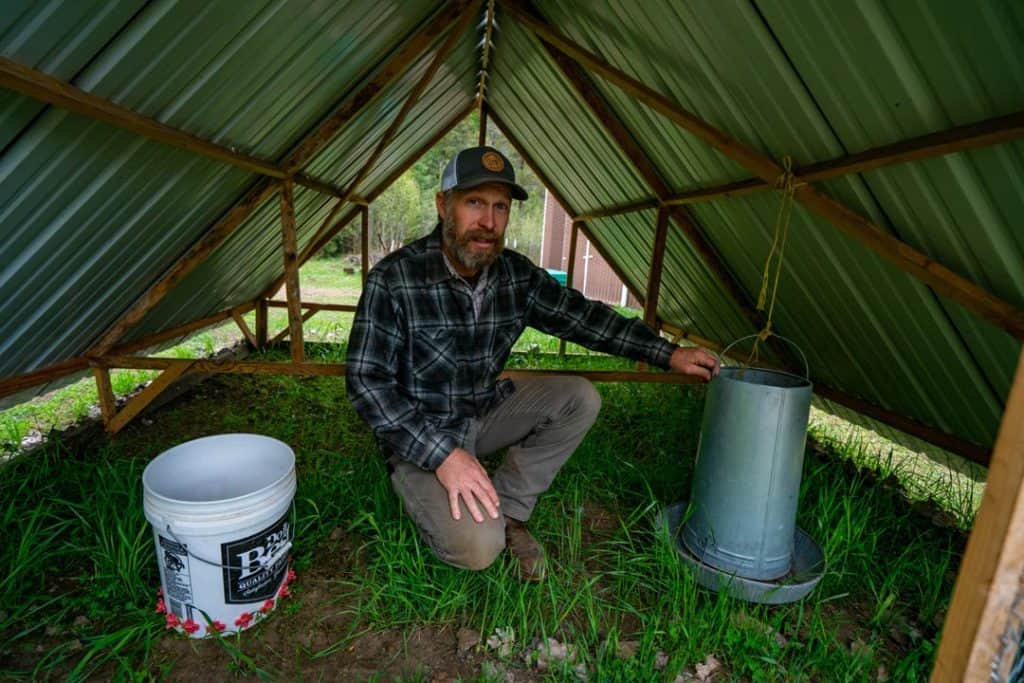
Shelter
Do not wait until you have your chickens to figure out where you will house them! It causes a lot of stress and could potentially affect the chicken’s health and well-being.
There are two types of chicken shelters:
- Permanent shelters – this is also called a static coop. It’s a coop that is permanent and cannot be moved daily or weekly. (See our static coop pictured below.)
- Moveable shelters – Also called chickshaws, chicken tractors, moveable chicken coops, or what we dubbed the Idaho A-Frame.
We use both a static coop and moveable coops for our chickens. Our meat chickens are solely in portable coops. But we provide a static coop for our laying hens during the winter months. We’ve even tried out the Happy Farmer Chicken Coop (you can read our review in that post).
A shelter, whether portable or permanent, needs to have certain elements:
- Protection from the elements
- Adequate size
- Temperature control
- Nesting boxes
- Roosts
- Security
Protection from the Elements
Your shelter must protect your chickens from the elements, be it sun, wind, rain or snow, heat, and cold. It’s also a good idea to learn how to identify common poultry diseases so you can correct any issues quickly.
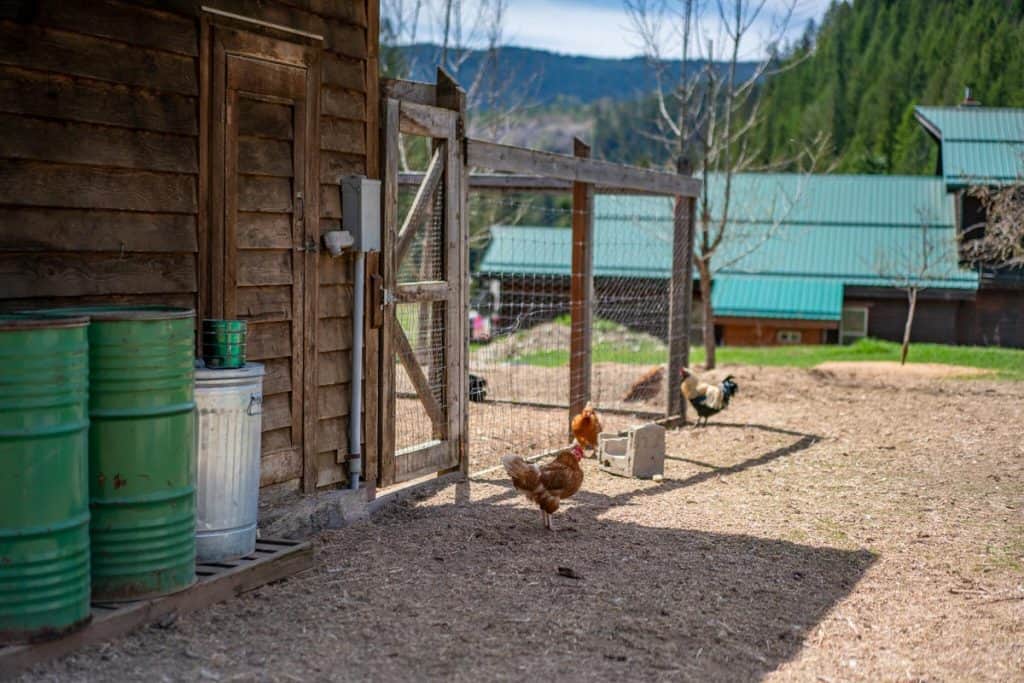
Adequate Size
You must have adequate space per chicken, or they can begin to get stressed and turn on each other, vying for their place in the coop. The minimum requirement is at least 2 square feet per bird inside the shelter and at least 2-3 square feet per bird in their outdoor area.
If chickens don’t have access to the outdoors, then providing them with 3-5 square feet per bird inside the coop is ideal.
Portable coops can have less square footage per bird because you’ll be moving the coop around. This provides them access to fresh grass and bugs on a regular basis. About 1-2 square feet per bird in a portable coop is adequate.
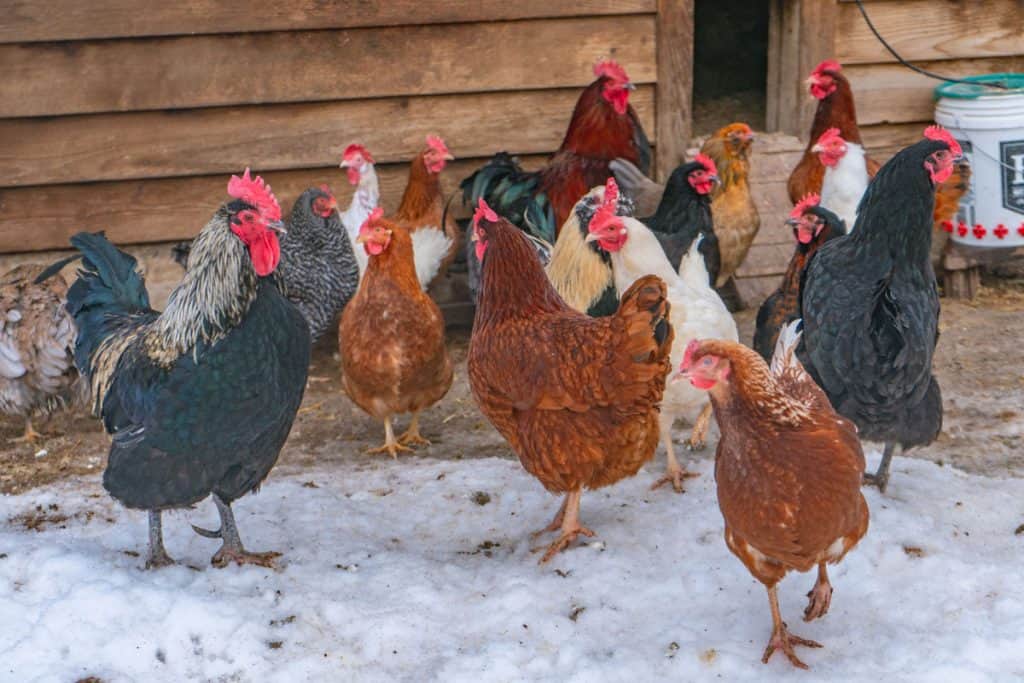
Temperature Control
When chickens are too hot or too cold, they get stressed. When chickens are stressed, they will slow down on their egg production. So, it’s very beneficial to make sure your chickens are happy with consistently comfortable temperatures.
Don’t worry about your chickens going out into the cold during the winter. They’ll regulate their temperature as long as they have access to somewhere out of the elements.
Inside their shelter, you want to allow for the most stable temperature control possible. This is mostly done through ventilation in the summer and insulation during the winter.
It’s a misnomer that temperature is what controls how many eggs a chicken lays. Sure, it can play a small part, but it’s actually due to the number of daylight hours. Up where we live in the far north of Idaho, we have very short winter days. As mentioned above, we allow for that natural slow in egg production for our chickens because we preserve them during their peak laying season.

Nesting Boxes
Always provide your chickens with a place to lay their eggs. If you don’t provide your chickens with nesting boxes, then they will find another place to lay, and you’ll have to hunt for them all over the place!
Within the nest boxes, you want to be sure to keep clean, fluffy straw and some wood shavings so it’s a comfortable place for the hens. This also keeps your eggs clean and keeps them from getting broken. Collecting clean eggs from the coop is much nicer than muddy or dirty eggs.
You need one nest box per 3-5 hens. You may find that your chickens tend to use one or just a few of your nest boxes. They like to do that, but it’s good practice to have one box per 3-5 hens.
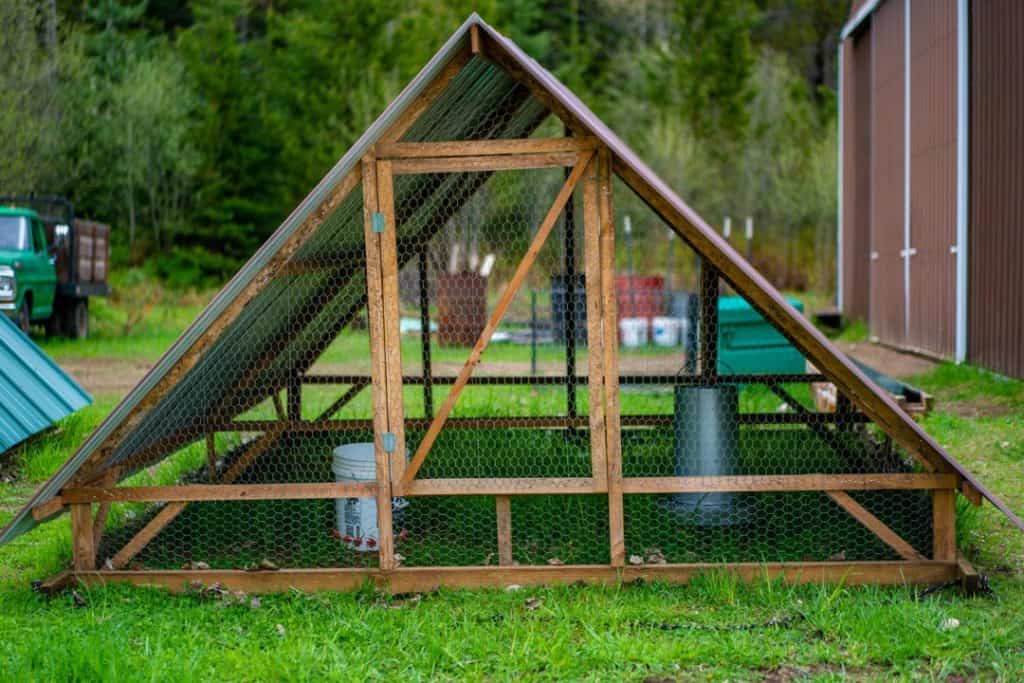
Roosts
Chickens prefer to roost while they sleep, where they can be up off the ground. They also like to be able to cluster together, so consider your size and spacing when setting up your coop. Having enough posts for your chickens is important.
Because chickens will spend a lot of time on their roosts, you’ll want to think through methods of collecting manure from under the roosts, as this is where it will tend to collect.
Some people like to place pans underneath the roosts to collect the manure, allowing them to easily remove it and add it to a pile to use as compost. If you’re using a mobile coop, you don’t need to worry about this, as you’ll be naturally fertilizing the grass as you move the coop daily.
Security & Protection
Getting backyard chickens is like putting up a sign for predators that says, “Free Food!” Even if you live in the suburbs, animals such as skunks, raccoons and dogs can become an issue.
If you live in a rural area, you need to consider the wildlife in your area. Where we live, we have a lot of coyotes, and even with all the noise of our kids, farm equipment, and animals, we’ve still had them come up, in plain sight, and snatch a chicken.

Permaculture & Raising Backyard Egg-Laying Chickens
Permaculture looks at the homestead as a whole and how it can work together. Implementing permaculture design on your homestead makes your chickens even more valuable (and accessible).
Using birds for permaculture means your chickens are providing you with more than one use (eggs or meat). Try implementing the deep litter bedding method in your permanent coop to create garden-ready compost.
Or, if you allow your chickens to go out to your pasture, whether free-ranging or in a portable chicken tractor, they can help control the fly population, fertilize the fields and still produce eggs for your family.
There are people who have full-on egg production systems that say the fertilization of their pastures is the higher value of what the chickens are producing, over and above the income of selling the eggs.
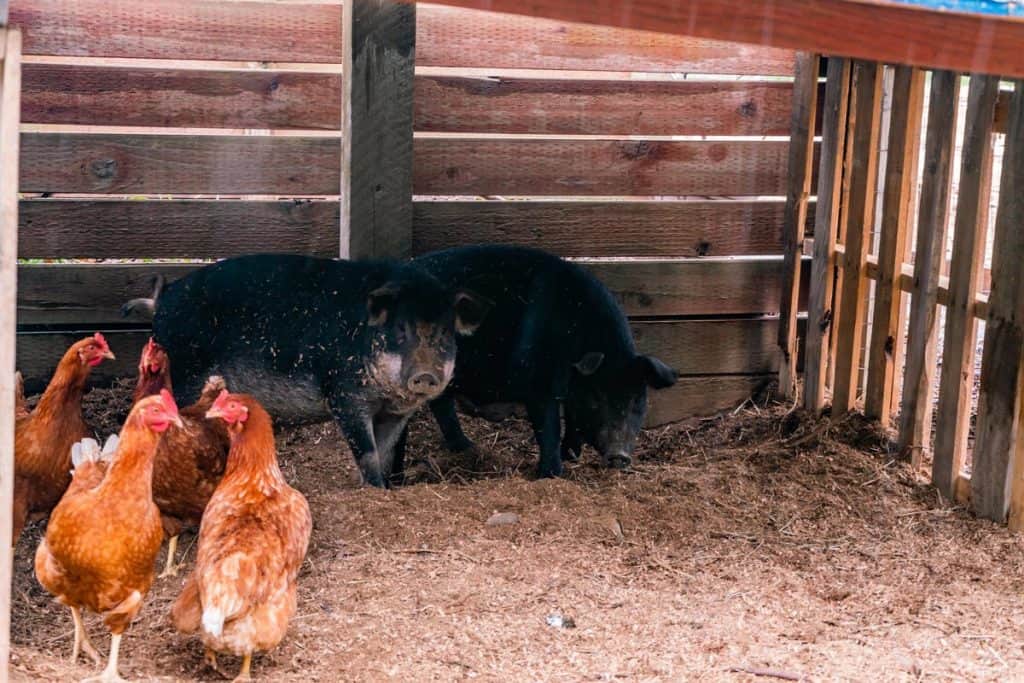
FAQs
When Do Chickens Start Laying Eggs?
Hens 4-6 months of age (otherwise known as pullets) will begin to lay eggs sporadically. They may not be up to speed with older hens, but you can expect to start getting eggs at about 4-6 months (depending on breed).
How Long Do Chickens Lay Eggs?
The average chicken will lay continuously for about 3-5 years, depending on the breed. Their best production will be in the first and second years. Then they will begin to slow down, and you’ll find you spend more to feed them than the return on eggs they produce.
This is generally why people like to layer in new hens every year or two to keep a fresh, productive flock.
Do Chickens Need a Rooster to Lay Eggs?
No, chickens do not need a rooster to lay eggs. However, if you plan to hatch out baby chicks, you will need a rooster to fertilize the eggs.
Be sure to check your HOAs (if applicable) because many places within city limits will allow you to keep female hens but not roosters.
What are the Best Egg Laying Chickens?
Some of our favorite egg-laying chicken breeds include Australorps, Brown Leghorns and Novogen Brown chickens, but there are many breeds to choose from. Some will even give you beautifully colored or speckled eggs!
Do Chickens Lay in the Winter?
It depends! Because chickens slow down their egg production when the number of daylight hours is reduced, how much chickens slow down in the winter will depend on where you live. The closer to the equator you live, the more regular egg production you’ll get.
Some people use artificial lights to keep winter egg production up, but we find the natural ebb and flow of egg production coinciding with the seasons is the most healthy for the birds.
Do Chickens Lay Eggs Every Day?
The average egg-laying chicken will produce about 300 eggs in a year. So during the spring, summer and fall, you may get about one egg per day (usually about 5-6 eggs per week) if the conditions are right. Then, the chicken may stop producing completely or slow down to about one egg per week during the winter months.
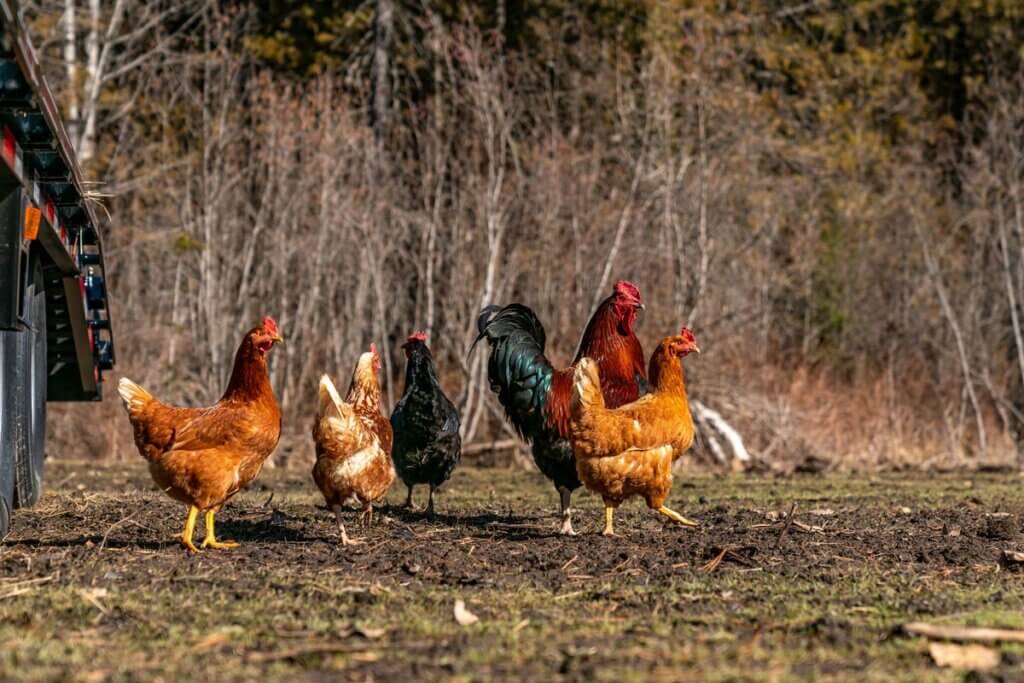
Related Articles
If you’re interested in raising backyard chickens, you may want to check out these posts:
- The Best Chicken Waterer for the Homestead
- Caring for Baby Chicks
- Chicken Tractor Basics
- Everything You Need to Know About Raising Meat Chickens
- Using Chickens to Restore the Land
- Broody Hen Management
- Butchering 1400 Pounds of Chickens
- How to Stock Your Barn for Winter
Podcast Links Mentioned:
- Sponsor: MadeOn Skin Care (Use code “homesteadingfamily” for 15% off!)
- Canning Safety & Canning: 101
- 5 Pressure Canning Mistakes
- The Abundant Pantry: Canning
Josh: Hey, guys. It's Josh.
Carolyn: And Carolyn.
Josh: With Homesteading Family, and welcome to this week's episode of Pantry Chat: Food For Thought.
Carolyn: Today, we're going to be talking about raising chickens for eggs. This episode of the Pantry Chat Podcast is sponsored by MadeOn Skin Care. MadeOn specializes in skincare specifically for dry skin, and they use as few ingredients as possible to get the job done. You guys, this is the type of skincare I would make myself if I had time to make it in my own home. The great thing is, Renee even shares her exact recipes with you.
Carolyn: The Bee Silk Lotion Bar is my go-to lotion when my hands get dry and cracked, and it's only made with three ingredients. Renee created it when she needed something to fix the splits in her fingers, cracks in her feet, and then she found out that it also worked great on our son's seasonal eczema. Go to hardlotion.com/homesteadingfamily to find out what Josh's favorite MadeOn products are, and also use the code Homesteading Family for 15% off today's purchase.
Josh: All right, you guys. Well, spring is almost upon us. It's getting there. Starting to warm up a little bit for us, and we're really making plans and thinking about everything out there on the property. One of the questions, one of the topics we've been getting asked a lot about is just chickens and some of both the basics and the details on egg laying chickens.
Carolyn: Yeah. We're going to cover that, and actually pretty good detail today in the main topic. But first, we have to do the chitchat.
Josh: Got to do the chitchat, and answer questions. Before we get to that question, how are you, and what's going on with you?
Carolyn: Well, I'm tired, I'm spring tired. You're supposed to have all this energy in spring, which you do. Some fresh sunshine and things starting to get a little green and poke up and grow a little bit. But then you use all that new energy to get the gardens and get everything ready. It's that time of year where the snow is now gone, we're able to actually get outside and do some work. I didn't clean up the cottage garden last fall when I should have. I didn't pre prep it, which is the best way to go, but I just didn't have the time. I just did not make that fit in.
Josh: I know. That's the reality. Just you can't do it all.
Carolyn: You just can't.
Josh: You got to be okay with yourself when that happens.
Carolyn: I decided that spring is a really good time to clean up the cottage garden and get everything composted and ready for this next year.
Josh: Hey, at least, it's right there on the southwest side of the house.
Carolyn: Yes.
Josh: It's one of the first places the snow is melting, which of course is a great place for garden.
Carolyn: Yes.
Josh: But it's also allowing you to get in there early before things are pushing on you too hard. Not much is really sprouting or coming up yet. It's nice.
Carolyn: Yeah, it is really great. I'm spending quite a bit of energy on that sort of thing, and projects out there. What about you?
Josh: Well, like you, which you didn't mention, I don't think, is the seed starting.
Carolyn: Yes.
Josh: Actually, starting some things earlier this year. I resonate with you in just feeling tired. Some of that is just the stress of the last year, coming into this year and really feeling the need to continue to up our game. To continue to grow more, to produce more, to put more up, to improve our systems. I had thought last year, okay, we're going to slow it down next year and take it a lot easier. In some ways we are, but in other ways, it's like, no, we need to push ahead. We need to keep developing systems.
Josh: There's just enough going on and I think you guys are feeling this. We all want to grow a little more food. We all want to put a little more up, we want to improve our backup system. With that, I'm getting things started earlier. I'm doubling up on peppers. We just keep not getting those ... Even the seed started early enough. So getting some of those done, just like you are, and you're doing some adding a lot to the kitchen garden, getting onions out there and I think I saw leeks, cabbages, broccolis. Thinking about all that, planning and just putting up the hoop house.
Carolyn: Yay!
Josh: The DIY hoop house, which is going to be a video on how to turn that beam tunnel into a very inexpensive hoop house or green house, again to give us an edge in our cold environment. We don't have the money for a big fancy hoop house. I'd loved one, but we're going to make do with what we've got, and also to extend that season, we're growing a lot more root crops, but we still like our tomatoes and peppers and cucumbers and we need to improve the systems there. That's what I'm working on, is getting that up and ready to accelerate the melt of the snow and warming up the soil with this passive system.
Carolyn: Yeah, great. Very good. Good, good.
Josh: Okay. That's it. Not much going on, is there?
Carolyn: Not much going on.
Josh: What are you guys up to? Let us know. Leave us a comment and let us know where you're at in your homesteading year and what you're up to and what you're struggling with or what you'd like to know about.
Carolyn: Yeah. You can probably tell we're a little tired. We're maybe a little subdued. We're working hard. We're getting into our year.
Josh: Yeah. That's right. It's all good stuff.
Carolyn: Yeah, okay.
Josh: We're winging it on the question. I don't remember who asked this question, other than I can tell you a lot of people ask this. I'm now pressuring her to do a video on it because it needs a deeper commentary than we can give here. But the basic question is, can I can in an Instapot?
Carolyn: Can I can in an Instapot?
Josh: We're getting this over and over and over. People really want to use their Instapots to can.
Carolyn: I know.
Josh: Pressure can.
Carolyn: It'd be really nice to have a one size fits all appliance in the kitchen, and the Instapot starts to come close to that. But the question can you can in an Instapot is challenging. First of all, you can water bath can in an Instapot.
Josh: That's cool.
Carolyn: Okay? You would not want to pressurize it, but in just its Instapot setting. Now, honestly, I would not recommend it because I think you're going to end up overcooking whatever it is that you have in there in order to bring that up to that steady rolling boil. But if you can bring up your Instapot to a rolling boil without pressurizing it and you can maintain it at that temperature for as long as your food needs to be processed, then you are technically safe to water bath can. Again, you have to also make sure that your jars are submerged by at least one to two inches of water in that sense.
Josh: Okay.
Carolyn: Okay? But what I think people really want to do is to pressure can-
Josh: That's really what they're.
Carolyn: ... in their Instapot.
Josh: They're trying to save money, I think. Totally get it. Save on resources.
Carolyn: Well, I think they're trying to save money, but the other thing is we've gotten comfortable with our Instapots now. We're using them in the kitchen, we're comfortable with it, and the pressure canner is honestly still a little scary. It's something we don't use very much, and it steams and makes a lot of noise and it's jiggly and things like that. The answer for that is no. Please do not pressure can in an Instapot. The reason for that is that ... If you really want to get into the science, you can check out my video training that I have on the safety of canning.
Carolyn: I actually go through all of the safety features of that. We'll make sure there's a link in the show notes and description here for that. But you have to be sure that you are bringing the contents of the food that are inside your jar all the way up to 240 to 250 degrees Fahrenheit in order to properly can them if there are low acid food. That would be the scenario where you would pressure can. The problem with an Instapot is you have no way of actually measuring the real pressure that you are pressurizing your Instapot to.
Carolyn: Even the types of electric pressure cookers that have a digital readout that shows you the pressure, you have no way of checking that and being sure that it's correct. Honestly, you guys, it's a life or death scenario. I hate to make it so big, but if you're not canning at the full pressure, you potentially have botulism in that jar that you haven't killed off.
Josh: That digital temperature for an Instapot or whatever you're using, that's more of an FYI. Where on a pressure canner, the gauge or the weight is a safety or regulated safety device.
Carolyn: That is correct. Even those dials on an actual pressure canner, you have to have those checked every single year because those can go wrong. You have to take them into a county extension office and have them actually check those in order for those to be deemed safe. You'll have to do that every year. You have no way of taking your Instapot anywhere and having it checked and calibrated. It's really important that you actually pressure can at the correct pressure in order to kill off all that bacteria that could be in the jar in order to have a safely sterilized jar of food that can sit on your shelf and not end up killing you or making you really, really, really sick.
Josh: You just don't want to take that chance.
Carolyn: You don't want to take that chance.
Josh: Carolyn's got a few great videos out there. But if you want to dive in, if this is the year that you just want to master canning, I'm just going to give a little plug here for Carolyn's class because she'll take you. She's excellent. She'll take you all the way through from zero knowledge, if that's where you're at or wherever you're at, to being totally confident and comfortable in that class. If you're concerned about getting food up this year, you're growing a larger garden, whatever it is you're doing but you know you want to get more on the shelves and this is the year to master this, just get the class and she'll take you all the way through, a lot further than any YouTube videos are going to do.
Carolyn: Yeah. It's all very safe. It teaches you all the very safe methods, so you be really confident about your foods.
Josh: Absolutely.
Carolyn: Yeah. Good.
Josh: Cool. All right. Well, that was a good question. Instapot, pressure canning, don't do it. Now, let's dive into chickens, and we're going to just cover the foundations and the basics of egg laying chickens.
Carolyn: Yes.
Josh: This is another area, it's a great entry point for you guys that are wanting to increase your food production. Another cool part we're not going to talk about so much today, but we'll reference, is that you can actually preserve and store eggs.
Carolyn: Yes. Yay!
Josh: That's going to add to that resiliency as well, even if you want to up your game with chickens, if you're just doing a few.
Carolyn: Okay. We are covering a lot today, so we better jump-
Josh: We better get to it.
Carolyn: ... right into it.
Josh: Okay. Where do you start? What breed do you start with? What do you need to know about breeds, and what breed do you start with?
Carolyn: Yeah, so-
Josh: How do we approach that?
Carolyn: Well, you really want to start by knowing what you want to do with your chickens, right?
Josh: Right.
Carolyn: If you were only ... You're trying to get as many eggs as possible out of your chickens, that's going to dictate what breed you get versus if you want a chicken that can be used for eggs, and then can eventually be used for a little bit of meat. That's going to be a different chicken versus a chicken that is just for meat, right?
Josh: Yep.
Carolyn: Usually, we classify chickens into four different categories. You've got your heritage breed chickens. These can actually fall within the other three categories too.
Josh: Right. These are just heritage. They're not your hybrids that have been developed for specific purposes. Yeah.
Carolyn: Right. Yeah. Then you have your specific egg laying breeds. These are going to be pretty skinny chickens usually.
Josh: Usually smaller.
Carolyn: They are not usually going to be good for putting in the pot after their egg laying lifecycle.
Josh: They can be heritage or they can be a hybrid.
Carolyn: Yes, they can be. Yeah. These types of chickens are going to lay somewhere around 300 eggs a year in optimal conditions. If you're looking mostly for egg laying chickens, these are the kinds of chickens that you're going to look for. This would be things like the Australorp-
Josh: The Leghorns.
Carolyn: The Leghorns.
Josh: Now, we have a hybrid, I think, that we're using. I can't remember the name of the-
Carolyn: The Novogen Browns.
Josh: The Novogen. Second year on those, and those are going, but they're specifically for egg layers, and those are going fantastic as well.
Carolyn: Yeah. Those have been really good too. Then you have something called the dual purpose breeds. This is with the idea that you have this chicken who's going to lay quite a few eggs, but still be large enough that you can get a little meat off of it in the long run.
Josh: Yeah. That's the idea, and I personally, after years and years, we've had a lot of dual purpose, I don't recommend them anymore. I think you want to get your egg layers for your egg layers. Now, they still ... The egg layers age out, slow down, and you can still use them for meat, and you want to do that to make good use of your resources. But get your egg laying chickens are best for your environment, whatever it is your requirements are, and get your meat chickens for your meat chickens. The dual purpose, a lot of people like it, but it just doesn't play it out well with that concept.
Carolyn: Well, if production is your main goal, then yeah, you're not ... I mean, most of your dual purpose birds are going to lay about 200, maybe up to 250 eggs a year in ideal conditions.
Josh: In ideal conditions, yeah.
Carolyn: You can see already that's between 50 and 100, a drop from those egg laying chickens. But the thing is you also don't get that much meat off of them. They're not doing the egg laying that great and they're not doing the meat production that great. Now, I've got to say though, I love these dual purpose birds because they often are your kind of backyard chickens. They're pretty, they are plucky. A lot of times, they're like the, things like that. They're-
Josh: Yeah, and they're a little more ...
Carolyn: ...because of all their feathers.
Josh: They are.
Carolyn: They're fun to have as diversity.
Josh: They're a little more handleable. A lot of times, the-
Carolyn: Yes.
Josh: ... egg layers are a little more wily, and it's definitely the get in the setting. So you're right, they are a little more nice backyard chickens.
Carolyn: They do have their place. But if you're really going for high production, you really, really want to go with those egg layers. Now I've got to mention the meat breeds real fast because sometimes if you've raised a bird for meat and it somehow escapes the butchering process, that can either be because-
Josh: Happens.
Carolyn: ... you lose heart and you decide not to butcher them. I've heard that happen in multiple cases. Or it literally escapes and gets out, and they end up being part of the egg laying flock. Those really are not going to be your best bet for egg layers. You're going to end up feeding them a lot of feed just to get very little bit of eggs.
Josh: Well, a lot of times, they'll continue to grow. The ones we've seen that happen with. That happened with a neighbor of ours, and he went ahead and experimented with that and went ahead and left them in the egg laying flock and they actually grew out about too big, and have problems just like your Cornish crosses have at eight weeks, 10 weeks. It just didn't work. They laid a few eggs. Yeah.
Carolyn: This is where you really need to know your use for the chickens and what your ultimate goal is. Again, we have gone to recommending go with the egg layers for the egg layers. Get the higher production egg layers and get your eggs out of them.
Josh: Yep. When you're looking, figure that out and then figure out your environment and what chickens are going to do best in your environment, talk to people and what you like. It's nice to have some variety. We've gotten a little less variety recently because we're focusing on production with all the people in our house, but it is important sometimes to enjoy. Chickens are fun to interact with and look at. You got to put all those pieces together.
Carolyn: Absolutely.
Josh: Okay. Next logical question is where are we going to get chicks from? Where to go. We've got a few ways to go out, that you can hatch eggs out.
Carolyn: Yes.
Josh: You can buy chicks, day-old chicks, you can get pullets, or you can get adults. Let's take them through that.
Carolyn: If you want to find hatching eggs, you can do that in all different ways. You can get them from a neighbor who has eggs that have been fertilized, you can get them from a lot of online sources, you can get them from a lot of hatcheries. Obviously, they have to be fertilized eggs in order to produce a chick. But what you need to know is that you would have to incubate those eggs before you're going to end up with a chicken, right? So you need an incubator setup, and then you'll need the brooder setup after that. It's pretty advanced, especially if you're just getting into chickens. You can get chicks, and oftentimes you're getting those as day old or a couple day-old chicks. That is the standard way to bring chickens into your flock.
Josh: Right. That is the most common method that most of us are using, and it's in all ways but one, it's a great system. Yeah.
Carolyn: What's the one way that it's not a great system?
Josh: Well, you're dependent on ... You are if you're buying hatching eggs as well, unless they're your own. But you're dependent on a resource far away, and that's working for us great. Now there may come a time or there may come seasons when that doesn't work so well. But this is what works right now, well for most people. It's day-old chicks.
Carolyn: Another thing that you can do is you can bring in pullets, which are between four to six months. These are usually at what's called point of lay where they're just about to start laying. The benefit to this is that you miss that entire chick period where you have to baby them and be mama hen essentially, right?
Josh: Yep.
Carolyn: Keep them warm, keep them fed. We'll talk about that in a few minutes. You have chickens that are old enough to go ahead and go right into the main coop and they're just about to start laying. That can be a benefit. The real con to that, I think there are a couple of them, but the real con to that is that they are expensive. They're usually much more expensive because somebody else has had to raise them out.
Josh: They usually are, but it is worth pricing it out and figuring out how much are your chicks costing, your system, your feed up to that point, because if you're in an area where there's not very many people doing pullets, then they're probably going to be expensive. But if you do happen to be an area where people are doing that, it is worth checking it out. It's going to cost you a little bit more in dollars no matter what, but it will save you the labor and the time, and it may be worthwhile. If you really like getting into the numbers, it's worth finding out what's available and crunching the numbers because that can be a good way to go.
Carolyn: Right. Another thing you can do is bringing an adult hens which would be your old type of range hens. They've already been laying. They're probably at their first molt, which is where they stopped laying for a little bit, they lose their feathers, growing new feathers, and they're probably already around that time. But then they should have at least a second and maybe even a third really productive laying season following that.
Josh: Some people sell them out at the first molt, after the first really productive round, because they want to just start over and get young chicks. That can be a way depending to get chickens laying already or are going to start laying again after the molt for a little lower cost and they're still going to produce pretty well for you.
Carolyn: If you're finding day-old chicks, which is really what I would recommend ... I don't know. We didn't really talk about that. Is that would you would recommend to somebody who's a beginner?
Josh: I think so generally. If you're really a beginner and you're worried about handling the babies and the system that comes with that, because there are and we'll talk about a little bit, there is a little bit to that, and you have pullets or adults available, that is a nice safety net because that fragile period has been dealt with. So if you don't mind paying that little bit extra cost, that can be good. But in general, yes. Getting the chicks is what most of us do because it's generally the most cost effective.
Carolyn: And it's going to give you the greatest variety. You'll have the biggest ability to pick your variety most likely. Always try to find them locally if you can, somebody who's already doing them. If you can find a mother-raised chicks ... A mother-raised. If you can find mother-raised chicks, that is really helpful, especially if you're hoping to have hens that will brood and raise their own checks. A chick that has had the experience of being mothered by an actual hen is already automatically going to be a better mother hen than one that was raised in a machine instead.
Josh: This is the ultimate solution. We all need to start doing this, even if we can't. It's a lot of time to devote to a breeding program. We've tried it at seasons and it's a lot of work and time when you're trying to produce.
Carolyn: Yes.
Josh: But if we all would just start taking ... Sometimes you get a good hen that she likes to set, try to encourage or try to set her aside. If we all started doing that, we'd start moving towards a little resiliency of having more hens that set and raise babies within our communities. That's a great solution just to this other problem of it's hard to find them locally. Well, we all just need to start doing a little bit and try to get that back into the breeding because it's been bred out because of our current system.
Carolyn: Yeah, absolutely. If you can't find them locally, which depending on where you are, it's very likely-
Josh: Probably not.
Carolyn: ... that you won't find them locally, unfortunately. But you should look for a local hatchery. If you can't find that, then of course, we have our online suppliers who will send you in the mail your day-old chicks.
Josh: We know.
Carolyn: They'll ship them out day-old.
Josh: We don't have that though. Just we're not selling checks.
Carolyn: We don't. Yeah.
Josh: Right. But there are many companies out there. The Freedom Ranger Hatchery is who we have been using for a few years now that we really, really like. Their chicks are strong, robust, healthy, and some of the ones that have been out there for a while that have grown, there's a lot of problems.
Carolyn: Some of the bigger hatcheries
Josh: Yeah. So do your homework. For sure.
Carolyn: Yeah, absolutely. Okay. Once you get those day-old chicks home-
Josh: Yep. You got to take care of them. They need a bit of ... They need a bit of mothering because they don't have a mother hen, so you've got to be the mother hen. We actually have a video on that. We're not going to go through all of that process here because that is a bigger topic.
Carolyn: We'll put a link to that video down in the description. But really quickly, you're going to have to have a brooder, which is a very, very safe ... It's like the nursery, right? You need to put them in this very safe, warm, protected, dry environment to get them up and running until they have feathers so that they can handle the actual space of the big coop and not be chilled or get killed off by exposure. Yeah.
Josh: Yep, absolutely. Check out that video if you need to learn how to get started.
Carolyn: Okay. Then how many chickens should you get?
Josh: As many as possible.
Carolyn: As many as possible. That's my answer to everything.
Josh: I love eggs for breakfast and I love eggs and everything.
Carolyn: You really, really need to start by considering your space.
Josh: Yes.
Carolyn: You should never have more birds-
Josh: Yes.
Carolyn: ... than you have the appropriate space for because you will just ... You'll asking for problems. If you overcrowd chickens, you're going to end up with disease, you're going to end up with aggressive chickens, poor chickens that start picking each other and start exhibiting antisocial behavior. Chickens do like to have buddies, so we do want to have more than one all the time, probably even more than two. But you do have to make sure to give them enough space. Generally, that's considered-
Josh: Three to five total, and we'll get into this in a minute with shelter and whatnot. Three to five square feet per bird inside and out is pretty good. I mean, we can do more. That's great. We'll get into more specifics here when we get into shelter, because it breaks down different ways now that we've got standard coops and all these different mobile situations. We can talk about that a little bit. But three to five feet. If you've just got a coop in a yard, you need at least that much per bird. Certain amount inside, certain amount outside.
Carolyn: Figure out your square footage and divide it by about five, and you'll know about how many birds you can house. It's important to remember that it's very common for chick or two to die in the process of being shipped in. It can be a good thing to get one or two extras.
Josh: order.
Carolyn: Make sure you have a little bit. Yeah.
Josh: Most of the chick, I'd say factories. That's what came to mind. Most of them will send you a couple extra, because that does happen.
Carolyn: Yeah, that's
Josh: Then, yes, figure for a little more and then sell a few of them if you've got too many. Give them away.
Carolyn: Yeah, few chicks. Yeah. The other thing you want to do is check to make sure you're not going to get yourself too many eggs or too few eggs. You want to think about the egg production of each chicken. In general, chickens in the height of their lay are considered to lay about four to five eggs per week. Now, there are definitely some amounts of time during the year where you won't be getting that many eggs. If it gets too hot, your chickens will stop playing. If it gets too cold or mostly too dark, they're going to stop laying.
Josh: Daylight hours is the main factor.
Carolyn: Anytime that there's less than about 12 hours of light, they're going to significantly slow down. You may have to add a few more chickens in order to make up for those facts.
Josh: You know what? They're definitely, in most places, going to really slow down in the winter. You can make use of the extra eggs during the week and in the production season and preserve those.
Carolyn: Yes
Josh: Another topic, but that is doable
Carolyn: Yes, so when you have a lot of eggs, you can preserve some for a time when you don't have as many.
Josh: Yeah, absolutely.
Carolyn: Good.
Josh: Okay. Moving on now to the breed, we've got the breeds, where to get them, how many. Now we want to start talking about housing them and how to take care of your chicks and your chickens.
Carolyn: Please do not wait until you have the chickens to figure out where you're going to house them. We're just saying. We're speaking from experience. We've done it a few times and it causes a lot of stress, and it usually causes problems with the chickens. Figure this out before you get the chickens.
Josh: Just not great care of the animals. There's two types of shelters, in general, right? There's permanent shelters, and there are moveable shelters. We're going to talk I think in and out here of needs on both of those on options.
Carolyn: Okay. Regardless of whether you have a permanent shelter, which is a fixed in place shelter, or you have one of those moveable shelters, a shelter chicken coop or shelter needs to have certain elements to it. The first is it needs to protect them from the weather and the elements. Right?
Josh: Right. Absolutely.
Carolyn: Pretty basic.
Josh: You got to protect them from the direct sun and heat, too much heat. You got to protect them from the wind, too much cold. That could be blowing snow.
Carolyn: You definitely want to try to get them a dry place because chickens don't like wet. Yeah.
Josh: Absolutely.
Carolyn: They also need to have an adequate amount of space.
Josh: Right. This is where you get into, depending on what kind of shelter you're dealing with, how you set it up. If you've got a permanent coop with a yard, you need at least two foot square foot per bird in the indoor part. Okay? As a square footage per coops, at least two, and at least that on the outside. That's where you're getting that three to five. That's four square foot per bird. More is better. If you can start getting three. Your coop doesn't need to be giant if it's a permanent coop indoors.
Josh: But consider wintertime. We've got a longer winner. The bigger that indoor coop is, since they've got to spend a lot more time inside, the batter. Like you said, they need to be active and do things or they'll turn on each other. Two is a minimum. If you don't have a big yard, then try to make that bigger. Then if you've got a fenced yard to go along with that, you at least want two. I'd start trying to get three to five at least for a permanent coop. Now, we want to try to see those chickens get out, right?
Carolyn: Yes.
Josh: We want to get them pasture, we want to get them free range. One way maybe, you may be able just to open the door to the coop and let them out on your property. We've done that a lot and that is a great way to go. If you're going to be in a horrible situation, either part of the year or if you're really warm, you can even do that all year. For us we've got to do both. We've got a regular coop, fixed coop. We're going to let them out of that sometimes of the year and then we're going to go take them in a portable situation.
Josh: Now, if it's a portable and you're getting them out and free ranging, those can be less square feet, because they're really not meant to spend a lot of time in there. They're going to go in there to roost and lay eggs. Their food is outside, their water is outside. Different examples of a portable coop would be a chickshaw, and that's just a cart that you move along with a built in little coop, a chicken tractor, and then just a larger portable coop. Usually guys that are doing market style, that scale, are going to use that.
Josh: But any of those, you're going to move around. The square footage can go down inside to one to two foot inside it because the chickens are really going to be out either totally free ranging or in a large netted area, ideally on pasture, and so they're moving around and they're just using that coop again at night and for a egg laying.
Carolyn: We love that system because it, one, spreads out the manure. It's actually beneficial for the ground because you're spreading the manure over your grounds. It's a great thing for an area that you want to bring the fertility of the soil back up. But it also gets the chickens under fresh ground every day. Chickens tend to like to congregate around their little house, and they put a lot of pressure right on the area around their house. They eat off all those bugs first, right? So we want to move them around the yard so that they're always having access to fresh food, more bugs, more fresh grass and greens, and they have clean ground to wander around on.
Josh: Of course, this is the permaculture mentality where you're starting to get multiple uses out of one object on your property, or on your farm. In this case, the chicken is not just providing your eggs, but the chicken is say controlling flies out in the pasture and fertilizing the field. There are guys that do full on egg production systems, but they actually see the fertilizing of the passion, what that does for the grass, for their grazing production as the higher value, and the eggs are just helping pay for it.
Carolyn: Because it's so valuable for the land.
Josh: Right. You don't have to be in large pastures to do this. You can take a few chickens, put them in a mobile situation, and move them around the half acre. I mean, even your yard if you wanted to do to get that benefit.
Carolyn: Yeah, good.
Josh: Chickens are much happier and they're going to do better.
Carolyn: Again, all of that drops your square footage requirements for your coop.
Josh: Yeah, yeah. I've seen them. We've got a chickshaw that's down to just about one square foot per bird, just a little bigger than that, and really that's for summertime where they're going to be out. It's got overhangs, they've got shade, their food's outside. They're just going in there to lay or to sleep. But you got to gauge that on your conditions. If there's more weather and they're going to have to spend a lot more time inside, I would definitely want to make that a little bigger.
Carolyn: [inaudible 00:31:36]
Josh: Yeah.
Carolyn: Yeah, okay. Now, the next thing we want to pay attention to for shelter is your temperature control. At least we talked about temperature, but maybe that's a misnomer, right? When things get too hot, or they get too cold, you put stress on the birds body. What we want to do ... When they get stressed, they slow down laying or they don't lay as much. You all know that feeling sitting out in the too hot sun and getting stress getting hot?
Josh: Right.
Carolyn: You don't want to do anything? Well, chickens get the same way, and their don't want to do anything relates to how many eggs you're going to get in the day or the week. What you want to do in that shelter is to provide them the most temperate climate possible for the area that you live in. That may actually have a lot more to do with ventilation than it does actually cooling the area down. Providing that shade and some good ventilation is really important in the summer because ventilation's always important for the health of the bird. In the winter, they will still lay in the cold, and chickens can actually survive a drastic amount of very cold.
Josh: Rarely, they get very cold.
Carolyn: But they're going to slow down as their body gets stressed. The more heat, the more insulation that you can provide for them, the more eggs you're going to get.
Josh: Yeah. The misnomer is just that that actually controls the egg laying. It's actually the daylight hours that control their egg production. But then where you can reduce stress on them, obviously the healthier they're going to be, the more eggs they're going to lay. As long as you've got the adequate shelter, that's great. If you're then able to insulate your coop, well, great. That takes it another step if you're in a cold environment. Some people go to the extent of heating and a little bit with a heat lamp or something like that. How much energy that uses, how far you want to go, that's really up to you. It's going to help, but it's not going to make a dramatic effect. Yeah.
Carolyn: Okay, so moving on, your shelter also needs to have nesting boxes. Now, this is important because your chickens are going to be laying, and if they don't start laying in your nest boxes, they will lay all over the place. A nest box is a place where you can actually keep the area clean and suitable so that you end up with eggs that aren't broken and aren't excessively dirty.
Josh: And are easy to find.
Carolyn: They're easy to find.
Josh: We've got a group of chickens that lay all over the barn.
Carolyn: Yes.
Josh: Because we're experimenting with little free ranging in the barn. It worked well in some ways, but others it didn't and we still find eggs everywhere for those few.
Carolyn: We do, yeah. You really want to have one nest box per three to five hens. They'll probably still all try to lay in just a few nest boxes.
Josh: Usually.
Carolyn: They like doing that. But it's important to have as many as you can.
Josh: They're most comfortable there. That little dark space with ... You want a little shavings or straw or something in there to protect the eggs. That's where they're comfortable. That's where they feel safe to brood to lay those eggs and think about setting them. But you still need another way for those chickens to hang out, right? To roost
Carolyn: Yeah. At nighttime, chickens like to get on their roosts, unless they're setting, and so you need to go ahead and provide some poles or something for those hens to roost on so they can be up above the ground. It makes them feel safe. They're up off the ground, and they to cluster together up there. It's their social environment for nighttime, right?
Josh: Yep. Yep.
Carolyn: The thing that you really have to pay attention to is that you're going to spend a lot of time on that roost, which means that the manure under the roost are really going to build up. You want to think through methods of collecting that manure. Try not to get yourself into a scenario where it's a really hard area to get back into to clean. Some people actually put things like pans or removable items underneath the roost, so that they can really easily just pull it out and go dump it out into their compost pile.
Josh: Yeah. Yep, good. Now another one we're touching on here, which we talked about, that's the outside roaming pen or the portable pen. But you bring up a good point in our notes here, that people are going to ask about free ranging because sometimes people have a lot of predator issues.
Carolyn: Yes.
Josh: Whether that's from the sky or coyotes, or whatever, and so you're maybe real nervous about getting those chickens out in free ranging, but you really do want to get them out and allow them to be a chicken. That's where the chicken tractors come in that people tend to think are more for meat chickens. But they can also be set up well for the egg laying chickens, where you move them regularly, but they're still in an enclosed enclosure and they're safe. They're protected. They can't quite range as much, but they do have production. That's another solution for that roaming side, which leads into one of our ... getting on our last points is security of the chickens.
Carolyn: You may think that just because the chickens are right in your backyard and they're close to the house, that maybe nothing is going to come in and bother your chickens.
Josh: Remember when I was building the deck for mom and dad?
Carolyn: Oh, yeah.
Josh: Yeah. That coyote came just 30 feet away from us.
Carolyn: Yeah. All of us were outside, air compressor's going, kids out playing, and the coyote came right up to the house, took a chicken and ran off right in plain sight.
Josh: Not only that, if you remember. We ran after it, got it to drop the chicken, and it left and it came back within a half an hour-
Carolyn: To come get the chicken again.
Josh: ... knowing we were all there. Depending on your environment, we were in a very coyote heavy environment there, you do really sometimes have to keep an eye in that.
Carolyn: Even if you're in a suburban area, getting chickens is like putting the sign out that says free food to every predator in the area, including raccoons, skunks. Anything that you can think of wants to come eat your chickens, so you have to make sure that you have a really secure coop. If you have neighbors who have chickens, it's really great to go ask them what kind of predators you're going to be facing and what's the best chicken fencing to handle that. In some places, you have to have elated coop, where there's chicken wire over the top of the coop at least at night. In other places you can get away with an open top coop.
Josh: Yeah. This is where I really like the chicken tractors because we really want to get away from the fixed coop model if we can. It breeds things that are not healthy, it's not the best for the chickens, and so if you can't just open the door on your coop and let them free range for a few hours a day, then that chicken tractors is great because it protects them but it still gets them the ability to get out and be a chicken. Well, hey, you know what? We've got one more key subject here to take care.
Carolyn: Oh yeah.
Josh: And that's-
Carolyn: We have these chickens, we have to feed it.
Josh: You got to feed them. Right? Seems a little out of order, but we do need to make sure they get fat. There's a lot of ways to do that, but there are some basic requirements and a basic place to start.
Carolyn: Absolutely. When your chicks are young, you need to feed them very high protein feed, and that's usually considered 18% to 20% protein. You get it either as chick starters, what it can be called chick crumbles. There's all sorts of names for it. But you're looking for that 18% to 20% protein feed in a really small crumble that little teeny chicks can digest.
Josh: Yep. We always do this, even though we've got a lot of alternative methods. We always make sure they're getting this. But a little pro tip that works really, really well is even when you're doing that, lay in some soil onto that newspaper or that surface that you're getting those. From day one, you can do this. If it's got some bugs in it, great. Throw in some grass or some greenery with that. That does a couple things.
Josh: The soil or the sand get starts to get grit in their gizzard and helps their digestion, along with getting them used to packing and scratching. That actually starts to get bred out of the chickens, so we want to bring that back in, and teach them how to get some of their own feed out of the natural environment. On that starting, even though you're giving them that high protein feed, you can add in some of the natural element from day one, and we found that really gives them a nice boost and trains them, as they grow, to get out there.
Carolyn: It also cultures them to actually eating the green things. I have seen other people's chickens who've never had access to anything green, and when they put green things in there, they won't touch it.
Josh: They don't know what to do with it.
Carolyn: They don't know what to do with it. Even if it's just a handful of grass, clippings or some weeds out of the yard, get some green things in there right off the beginning. As they get bigger, the standard advice from about eight to 14 weeks is to move to a 16% to 18% protein feed. The reason for this we want to drop that protein a little bit because we don't want them to grow too quickly.
Carolyn: We don't want them to develop their egg laying parts too quickly because that can cause some health issues for the long term laying. We also don't want them to develop the rest of their body faster than their legs can contain it. You want to drop down that protein. You actually drop it again from about 15 to 18 weeks down to something closer to a 15% feed. Now, this is really idealized, I got say.
Josh: This is very technical. [crosstalk 00:40:50] Yeah.
Carolyn: This is really technical, and we don't always follow all of this. So you take it and run with it the way you can. We definitely always start with a chick starter, and then when they get to about 16 weeks where they're about to hit point of lay, they're starting to come on to adults, they're fully feathered, they're ready to be ... they've been out in the coop, the main coop, then it's time to drop them down to that 16% layer feed.
Josh: Right. Yep. Depending on the season and their development, I'd like to see them getting pretty fully feathered and again depending on the weather, to start getting them out. But the sooner we can get them out and free ranging and going after bugs and grasses and all that, that helps supplement their feed and really helps them just develop a good health and a good robustness. Your eggs. You're going to see the difference in your eggs with that. Then you can get into also fermenting grains.
Carolyn: Yes.
Josh: Both for making better use out of maybe lower cost grains, scratch mixes or individual grains, or just adding in those extra nutrition and probiotics. Another thing you can do is the kitchen scraps, and there's a lot of good protein and a lot of good feed there as well.
Carolyn: Yeah, it's a great way to use your kitchen scraps too.
Josh: It is for us until the pigs.
Carolyn: Until the pig show up, and they want it instead.
Josh: The pigs make better use of it. Yep.
Carolyn: Hey, you guys, it's been great to hang out with you. Check out our blog post on what to do with all of those fresh eggs that you're about to get after you get your chickens and they are laying. That link should be in the description.
Josh: Thanks for listening to this episode of the Pantry Chat: Food For Thought. If you've enjoyed this episode, please subscribe, rate, and review.
Carolyn: To view the show notes and any other resources mentioned on this episode, you can learn more at homesteadingfamily.com/podcast.
Josh: We'll see you soon.
Carolyn: Goodbye.
Sign up to receive email updates
Enter your name and email address below and I'll send you periodic updates about the podcast.


















